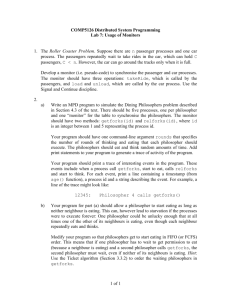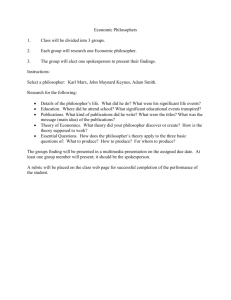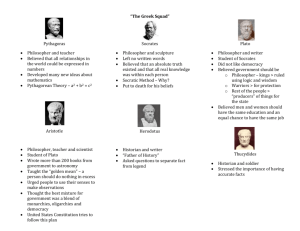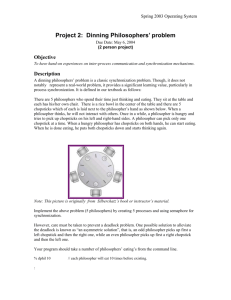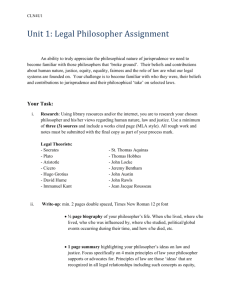Answer
advertisement
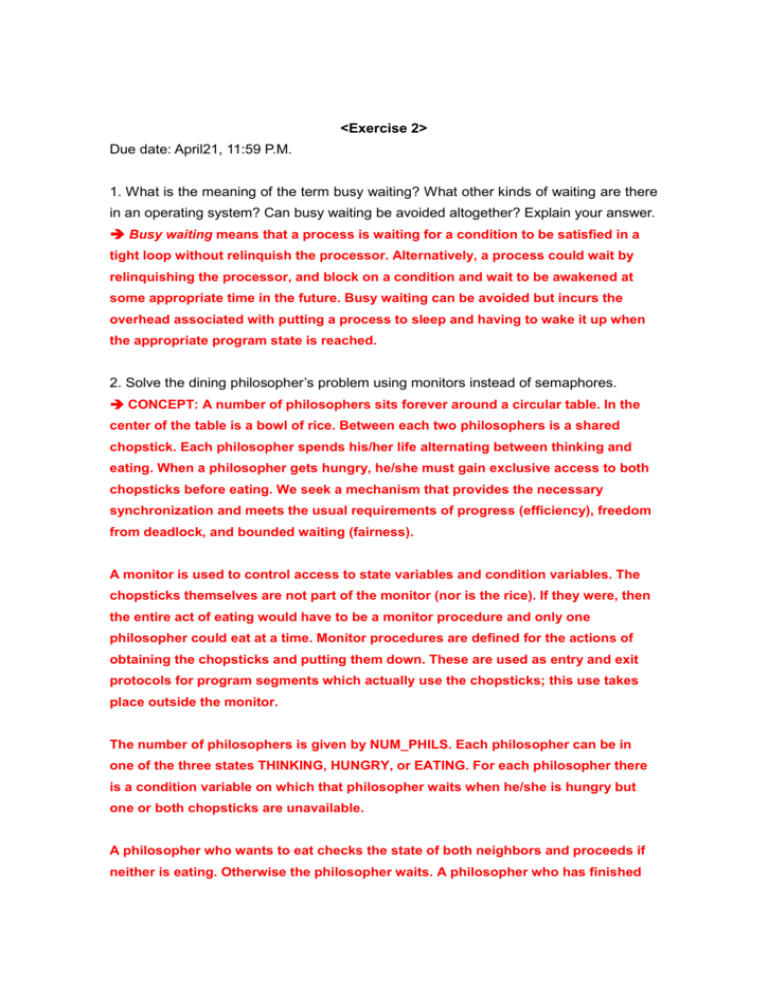
<Exercise 2>
Due date: April21, 11:59 P.M.
1. What is the meaning of the term busy waiting? What other kinds of waiting are there
in an operating system? Can busy waiting be avoided altogether? Explain your answer.
Busy waiting means that a process is waiting for a condition to be satisfied in a
tight loop without relinquish the processor. Alternatively, a process could wait by
relinquishing the processor, and block on a condition and wait to be awakened at
some appropriate time in the future. Busy waiting can be avoided but incurs the
overhead associated with putting a process to sleep and having to wake it up when
the appropriate program state is reached.
2. Solve the dining philosopher’s problem using monitors instead of semaphores.
CONCEPT: A number of philosophers sits forever around a circular table. In the
center of the table is a bowl of rice. Between each two philosophers is a shared
chopstick. Each philosopher spends his/her life alternating between thinking and
eating. When a philosopher gets hungry, he/she must gain exclusive access to both
chopsticks before eating. We seek a mechanism that provides the necessary
synchronization and meets the usual requirements of progress (efficiency), freedom
from deadlock, and bounded waiting (fairness).
A monitor is used to control access to state variables and condition variables. The
chopsticks themselves are not part of the monitor (nor is the rice). If they were, then
the entire act of eating would have to be a monitor procedure and only one
philosopher could eat at a time. Monitor procedures are defined for the actions of
obtaining the chopsticks and putting them down. These are used as entry and exit
protocols for program segments which actually use the chopsticks; this use takes
place outside the monitor.
The number of philosophers is given by NUM_PHILS. Each philosopher can be in
one of the three states THINKING, HUNGRY, or EATING. For each philosopher there
is a condition variable on which that philosopher waits when he/she is hungry but
one or both chopsticks are unavailable.
A philosopher who wants to eat checks the state of both neighbors and proceeds if
neither is eating. Otherwise the philosopher waits. A philosopher who has finished
eating gives each neighbor a chance to eat, if they are hungry and if their other
chopstick is free.
MONITOR:
DATA:
condition can_eat[NUM_PHILS];
enum states {THINKING, HUNGRY, EATING} state[NUM_PHILS-1];
int index;
INITIALIZATION:
for (index=0; index<NUM_PHILS; index++) {
flags[index] = THINKING;
}
MONITOR PROCEDURES:
/* request the right to pickup chopsticks and eat */
entry void pickup(int mynum) {
/* announce that we're hungry */
state[mynum] = HUNGRY;
/* if neighbor's aren't eating, proceed */
if ((state[mynum-1 mod NUM_PHILS] != EATING) &&
(state [mynum+1 mod NUM_PHILS] != EATING)) {
state[mynum] = EATING;
}
/* otherwise wait for them */
else can_eat[mynum].wait;
/* ready to eat now */
state[mynum] = EATING;
}
/* announce that we're finished, give others a chance */
entry void putdown(int mynum) {
/* announce that we're done */
state[mynum] = THINKING;
/* give left (lower) neighbor a chance to eat */
if ((state [mynum-1 mod NUM_PHILS] == HUNGRY) &&
(state [mynum-2 mod NUM_PHILS] != EATING)) {
can_eat[mynum-1 mod NUM_PHILS].signal;
}
/* give right (higher) neighbor a chance to eat */
if ((state [mynum+1 mod NUM_PHILS] == HUNGRY) &&
(state [mynum+2 mod NUM_PHILS] != EATING)) {
can_eat[mynum+1 mod NUM_PHILS].signal;
}
}
PHILOSOPHER:
/* find out our id, then repeat forever */
me = get_my_id();
while (TRUE) {
/* think, wait, eat, do it all again ... */
think();
pickup(me);
eat();
putdown(me);
}
3. The banker's algorithm is being run in a system with m resource classes and n
processes. In the limit of large m and n, the number of operations that must be
performed to check a state for safety is proportional to manb. What are the values of a
and b?
Comparing a row in the matrix to the vector of available resources takes m
operations. This step must be repeated on the order of n times to find a process that
can finish and be marked as done. Thus, marking a process takes on the order of mn
steps. Repeating the algorithm for all n processes means that the number of steps is
then mn2.
4. Compare the circular-wait scheme with the deadlock-avoidance schemes (like the
banker’s algorithm) with respect to the following issues:
a. Runtime overheads
b. System throughput
A deadlock-avoidance scheme tends to increase the runtime overheads due to the
cost of keep track of the current resource allocation. However, a deadlock-avoidance
scheme allows for more concurrent use of resources than schemes that statically
prevent the formation of deadlock. In that sense, a deadlock-avoidance scheme
could increase system throughput.
5. Consider the following snapshot of a system:
Allocation
Max
Available
ABCD
ABCD
P0 0 0 1 2
0012
1520
P1 1 0 0 0
1750
P2 1 3 5 4
2356
ABCD
P3 0 6 3 2
0652
P4 0 0 1 4
0656
Answer the following questions using the banker’s algorithm:
a. What is the content of the matrix Need?
The values of Need for processes P0 through P4 respectively are (0, 0, 0, 0), (0,
7, 5, 0), (1, 0, 0, 2), (0, 0, 2, 0), and (0, 6, 4, 2)
b. Is the system in a safe state?
Yes. With Available being equal to (1, 5, 2, 0), either process P0 or P3 could
run. Once process P3 runs, it releases its resources which allow all other
existing processes to run.
c. If a request from process P1 arrives for (0,4,2,0), can the request be granted
immediately?
Yes it can. This results in the value of Available being (1, 1, 0, 0).One ordering
of processes that can finish is P0, P2, P3, P1, and P4.
6. What advantage is there in having different time-quantum sizes on different levels of
a multilevel queuing system?
Processes that need more frequent servicing, for instance, interactive
processes such as editors, can be in a queue with a small time quantum.
Processes with no need for frequent servicing can be in a queue with a larger
quantum, requiring fewer context switches to complete the processing, making
more efficient use of the computer.
7. Three processes are running on the following figure time line.
0
P0
10
CPU (10)
P1
P2
CPU(4)
20
I/O (11)
CPU(9)
I/O(16)
I/O(4) CPU (4)
I/O(12)
30
CPU(4)
40
CPU(8)
I/O (8)
CPU(7)
CPU(6)
I/O(4)
CPU (6)
For each of the following scheduling algorithms, draw four Gantt charts and determine
the average waiting time.
50
a. SJF (preemptive)
b. Priority (Non-preemptive) (Priority - P0: 1, P1: 2, P2: 3)
c. RR (Quantum = 5)
d. Multi-level queue (Priority - P0: 1, P1 & P2: 0), SJF (preemptive) with priority 0,
FCFS with priority 1, Fixed Priority Queue & Preemptive


